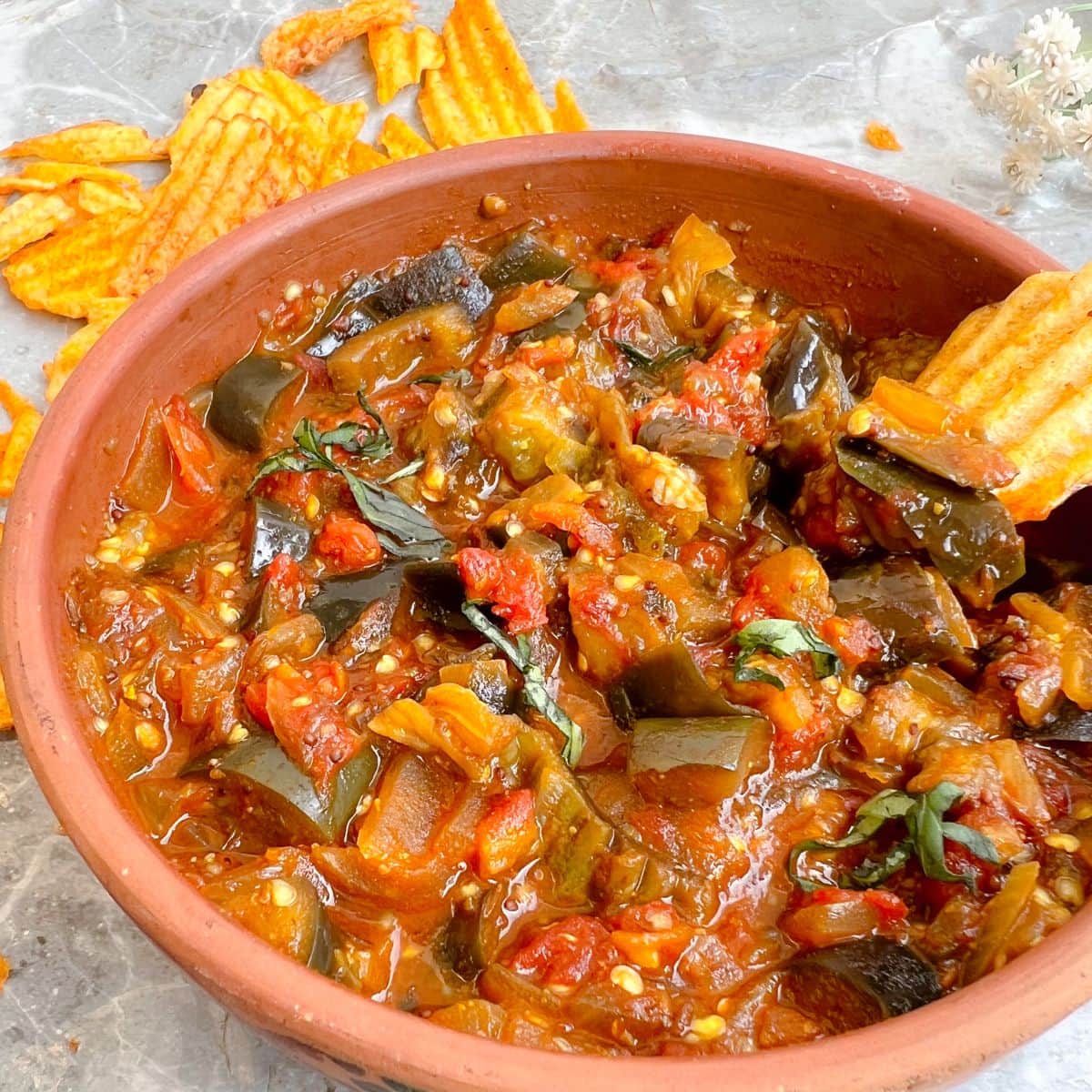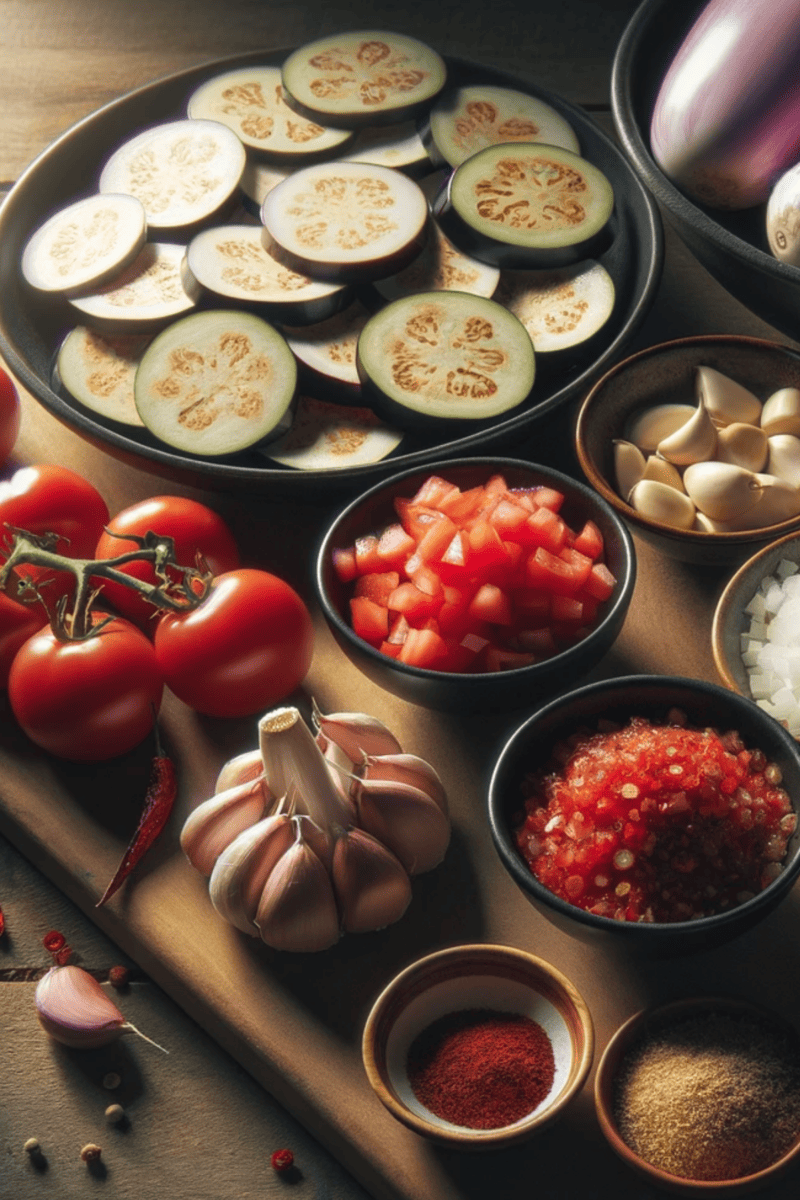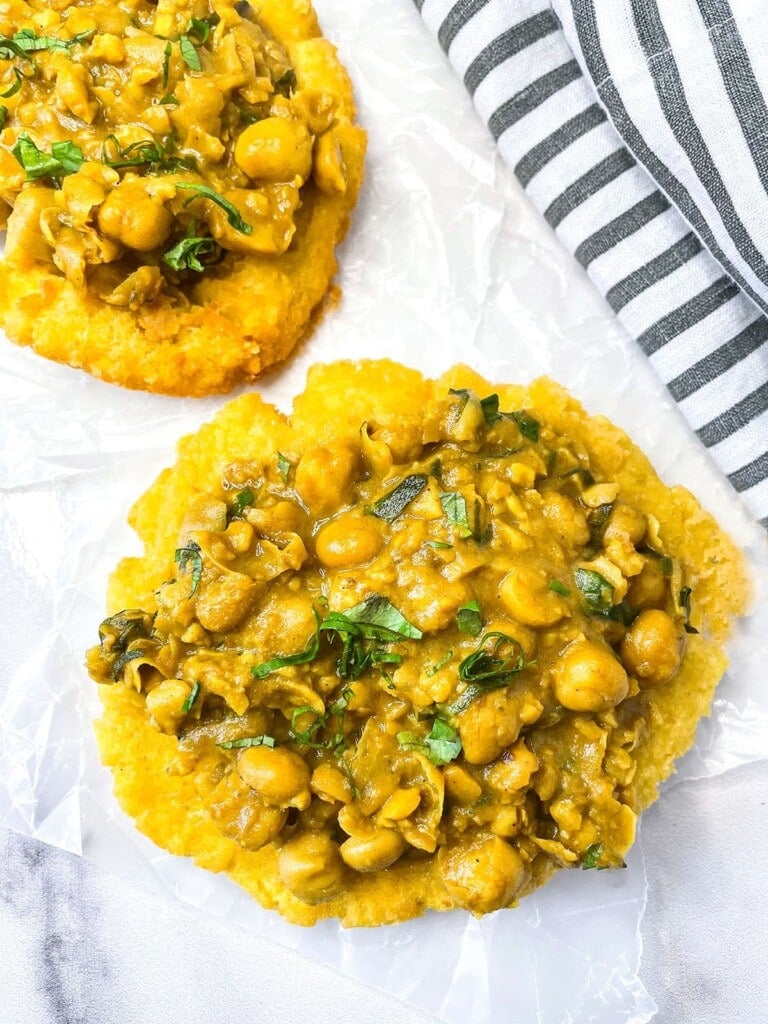Eggplant And Tomato Chutney
This savory, spicy chutney pairs well with Indian cuisine or is used as a dip for crackers. Additionally, it is fantastic as a relish in wraps or sandwiches.
You frequently use eggplant in recipes, but have you ever tried eggplant chutney? This unique creation has an exquisite flavor and pairs well with rice, roti, and bread in wraps or sandwiches.
Eggplant is my favorite vegetable (if you didn’t already know), and I frequently buy them as I love making Eggplant Fatteh, Vegan Stuffed Eggplant, Eggplant Chickpea Curry, Eggplant Pizza Bites, and Fried Eggplant (especially in the winter).
I recently make Lentil Oat Dosa and wanted to enjoy it with some savory, spicy, and tangy chutney. I looked in my fridge and found an eggplant. I decided to make this amazing vegan eggplant and tomato chutney. With minimal prep time, this chutney is quite easy to make, and the combo of eggplant and tomato is simply divine.
The proportions in this recipe were an experiment. I tried it a couple of times, and each time it worked out perfectly! What gives it a lot of flavor without overpowering it is the spice ratio.
This vegan eggplant and tomato chutney is delicious, tangy, and spicy. It can be used as a dip, spread, or salsa. It keeps well for several months if stored in airtight jars in a cool place.
Scroll down for the detailed recipe, but I request that you don’t skip reading the important information included in the blurb.

Importance Of Chutney In South Asian Cuisine
If you grew up in a South Asian home, you would agree that chutneys are an integral part of the region’s cuisine. The various herbs, spices, vegetables, and fruits that go into making these flavorful condiments are ground or cooked together. They are typically served as accompaniments to enhance the taste of a meal. No dinner is complete without some chutney.
If, for whatever reason, there is no freshly made chutney on any particular day, there are at least two or three types of pickles in the pantry!
Despite their common association with South Asia, chutneys are also widely consumed throughout Africa and the Caribbean.
Here are some reasons why chutneys are important in South Asian homes:
- Flavor Enhancement: Chutneys add a burst of flavor to every dish. They provide a balance of tanginess, spiciness, and freshness, complementing the main dishes. Chutneys are often used to enhance the taste of idli, dosa, vada, rice, and other staples.
- Nutritional Value: Chutneys are usually made with fresh ingredients like herbs, vegetables, and fruits, which are rich in essential vitamins, minerals, and antioxidants. For example, mango chutney is a very popular variant in South India, providing healthy fiber and nutrients.
- Digestive Benefits: Many chutneys contain ingredients like ginger, garlic, and tamarind, which aid digestion. These ingredients can help alleviate stomach-related issues.
- Cooling Effect: South Asia is known for its warm climate, and chutneys, especially those made with ingredients like mint and curd, have a cooling effect on the body. They help counterbalance the heat of spicy dishes and provide a refreshing element to the meal.
- Traditional Heritage: Chutneys have been a part of South Indian culinary traditions for generations. They represent the rich cultural heritage and culinary expertise of the region. Many families have their unique chutney recipes passed down through the years, creating a sense of tradition and nostalgia.
- Versatility: South Indian chutneys come in a wide range of flavors and textures. They can be made with various ingredients, allowing for versatility in taste and presentation. Chutneys can be spicy, tangy, sweet, or a combination of these flavors, catering to individual preferences.
Is This Vegan Eggplant and Tomato Chutney Healthy?
Eggplant contains a diverse range of health advantages, including the ability to support the development of strong bones and avoid osteoporosis, lessen anemic symptoms, and enhance cardiovascular health. It contains a lot of vitamins, including C, K, and B6. Tomatoes, onion, green chilies, and garlic, some other key ingredients, also contribute to the chutney’s healthfulness.
Required Ingredients

- Eggplant: I used 1 large eggplant. Look for a fresh and vibrant one.
- Tomatoes: I used two ripe tomatoes.
- Onion: I used 1 medium red onion. You may use a white or yellow one.
- Garlic: I used 3 freshly minced garlic cloves.
- Green chili pepper: Optional to bring some exciting heat punch.
- Vegetable oil: I used olive oil.
- Mustard and cumin seeds: for added taste and aroma.
- Turmeric powder: for earthiness, warmth, and color.
- Paprika: To further enhance the flavor.
- Ground coriander: The flavor of ground coriander seeds is sweet, aromatic, and slightly citrusy.
- Ground cumin: I also add ½ tsp of ground cumin to add some more flavor.
- Red chili powder: It’s optional to add red pepper.
- Brown sugar or jaggery: to sweeten the chutney.
- Apple cider vinegar or lemon juice: to provide acidity.
- Salt: To bring the flavors together
- Fresh cilantro leaves for garnish
How To Make Vegan Eggplant and Tomato Chutney?
- Heat the vegetable oil in a large pan or skillet over medium heat. Add the mustard seeds and cumin seeds. Allow them to sizzle and pop for a few seconds.
- Add the chopped onions to the pan and sauté until they turn translucent and slightly golden. Stir in the minced garlic and chopped green chili pepper, and cook for an additional minute.
- Add the diced eggplant to the pan and stir well. Cook for about 5 minutes until the eggplant starts to soften.
- Now, add the diced tomatoes, turmeric powder, paprika, ground coriander, ground cumin, and red chili powder (if using). Mix everything together until well combined.
- Reduce the heat to low, cover the pan, and let the chutney simmer for about 15-20 minutes, or until the eggplant is fully cooked and tender. Stir occasionally to prevent sticking.
- Once the eggplant is cooked, add the brown sugar (or sweetener of choice), apple cider vinegar (or lemon juice), and salt to taste. Stir well to incorporate the flavors.
- Continue cooking the chutney uncovered for an additional 5 minutes, allowing the excess moisture to evaporate and the flavors to meld together.
- Remove the pan from the heat and let the chutney cool to room temperature. Garnish with fresh cilantro leaves.
Serving Suggestions
Serve the vegan Eggplant and Tomato Chutney as a dip with crackers, as a side with vegan curries, or as a condiment for sandwiches and wraps. This chutney also goes well with some steamed rice, upma, idli, dosa, or roti. Enjoy its rich and tangy flavors!
Recipe Notes
- You can either cut the ingredients as directed in the recipe, chop them into smaller pieces, or puree them after cooking with an immersion blender (though it may resemble a dip more than the chopped eggplant chutney, it will be just as tasty.).
- To get a smoky flavor, you may roast or grill the tomatoes and eggplant before adding them to the recipe. Roasted eggplant & tomatoes will substantially enhance the flavor and taste of this chutney.
- This gluten-free chutney can be stored in an airtight container in the refrigerator for up to a week.
If You Like This Recipe You May Also Love Trying These:
- Roasted Tomato Dip
- Garlic Red Chili Chutney
- Mint and Cilantro Chutney
- Vegan Eggplant Dip
- Tamarind Chutney (No Added Sugar

Frequently Asked Questions
What Is Chutney?
Chutney is a condiment or sauce that originated in the Indian subcontinent. It is typically made by grinding, blending, or cooking various ingredients together to create a thick, flavorful sauce. Chutneys can be sweet, savory, or spicy.
Chutneys are typically served as a side dish or condiment with meals. They add a burst of flavor and can complement a wide range of dishes, including curries, grilled or fried meats, rice, samosas, and snacks. Chutneys can also be used as a spread in sandwiches or as a dip for appetizers.
What Are The Best Ways To Eat Eggplants?
Eggplants can be cooked in a variety of ways, including on the grill, in the oven, on the griddle, on the barbecue, in a casserole, or a curry. Famous dishes include imam bayildi, caponata, miso aubergine, moussaka, parmigiana, and ratatouille.
How Do You Remove Toxins From Eggplant?
Cut the eggplant in half, then season one side with salt (coarse salt works best because it absorbs the least amount of liquid). Brush it off with a moist cloth after allowing it to sit for 30 minutes to allow the solanine, a substance present in the flesh, to seep away.
Or another option is to soak cubes or slices of eggplant in milk for roughly 30 minutes before cooking. In addition to taming the bitterness, milk also contributes to the extra-creamy texture of eggplant by acting as a sponge to absorb a significant amount of milk into the vegetable’s flesh.
Should I Peel Eggplant?
You don’t need to. With larger eggplants, the skin can be a little rough, but it is still quite edible. When the eggplant is young, delicate, and smaller in size, the skin, which is rich in nutrients, can be left on for cooking or frying.
Give this eggplant-tomato chutney recipe a try. It’s incredibly delicious and super easy. I hope you like it. And I would love to hear from you. So, if you tried this recipe or any other from my website, please let me know how it turned out in the comments below!
Want to Save This Recipe?
Enter your email & I’ll send it to your inbox. Plus, get great new recipes from me every week!
By submitting this form, you consent to receive emails from Healthier Steps.

Vegan Eggplant and Tomato Chutney
Equipment
Ingredients
- 1 large eggplant diced
- 2 ripe tomatoes diced
- 1 medium onion finely chopped
- 3 cloves of garlic minced
- 1 green chili pepper finely chopped (optional, adjust to taste)
- 1 tablespoon vegetable oil
- 1 teaspoon mustard seeds
- 1 teaspoon cumin seeds
- 1 teaspoon turmeric powder
- 1 teaspoon paprika
- 1 teaspoon ground coriander
- 1/2 teaspoon ground cumin
- 1/2 teaspoon red chili powder optional, adjust to taste
- 1 tablespoon brown sugar or jaggery
- 1 tablespoon apple cider vinegar or lemon juice
- Salt to taste
- Fresh cilantro leaves for garnish
Instructions
- Heat the vegetable oil in a large pan or skillet over medium heat. Add the mustard seeds and cumin seeds. Allow them to sizzle and pop for a few seconds.
- Add the chopped onions to the pan and sauté until they turn translucent and slightly golden. Stir in the minced garlic and chopped green chili pepper, and cook for an additional minute.
- Add the diced eggplant to the pan and stir well. Cook for about 5 minutes until the eggplant starts to soften.
- Now, add the diced tomatoes, turmeric powder, paprika, ground coriander, ground cumin, and red chili powder (if using). Mix everything together until well combined.
- Reduce the heat to low, cover the pan, and let the chutney simmer for about 15-20 minutes, or until the eggplant is fully cooked and tender. Stir occasionally to prevent sticking.
- Once the eggplant is cooked, add the brown sugar (or sweetener of choice), apple cider vinegar (or lemon juice), and salt to taste. Stir well to incorporate the flavors.
- Continue cooking the chutney uncovered for an additional 5 minutes, allowing the excess moisture to evaporate and the flavors to meld together.
- Remove the pan from the heat and let the chutney cool to room temperature. Garnish with fresh cilantro leaves.
- Serve the vegan Eggplant and Tomato Chutney as a dip with crackers, as a side with vegan curries, or as a condiment for sandwiches and wraps. Enjoy its rich and tangy flavors!
Notes
- To enhance the flavor of the chutney, you can roast the diced eggplant in the oven before adding it to the pan. This will give it a smoky flavor and a softer texture.
- If you prefer a spicier chutney, you can increase the amount of green chili pepper or add some red chili flakes during the cooking process.
- Don’t be afraid to experiment with different spices and herbs to customize the flavor of the chutney. You can try adding a pinch of garam masala, curry powder, or even fresh ginger for an extra kick.
- Adjust the sweetness and tanginess of the chutney according to your preference. If you like it sweeter, add more brown sugar or sweetener. Similarly, if you prefer it tangier, increase the amount of apple cider vinegar or lemon juice.
- For a smoother consistency, you can blend the chutney using a food processor or blender. This will create a more uniform texture while still preserving the flavors.
- Chunky Vegetable Chutney: Feel free to add other vegetables like bell peppers, zucchini, or carrots to the chutney for added texture and flavor. Simply dice them and sauté along with the eggplant.
- Mediterranean Twist: Add a Mediterranean touch by incorporating ingredients like olives, capers, or sun-dried tomatoes into the chutney. These additions will infuse the chutney with a unique and savory flavor.
- Creamy Chutney: To make the chutney creamier, stir in coconut milk or vegan yogurt towards the end of the cooking process. This will add a luscious texture and a hint of creaminess to the chutney.
- Citrus Burst: For a refreshing twist, squeeze some fresh lime or lemon juice over the chutney just before serving. This will add a zesty and citrusy flavor that complements the earthiness of the eggplant and tomatoes.
- Spiced Chutney: If you prefer a spicier version, add spices like crushed red pepper flakes, chili powder, or even a pinch of cayenne pepper to intensify the heat. Adjust the spice level according to your taste preferences.







Thank you very much!
Glad you liked it!